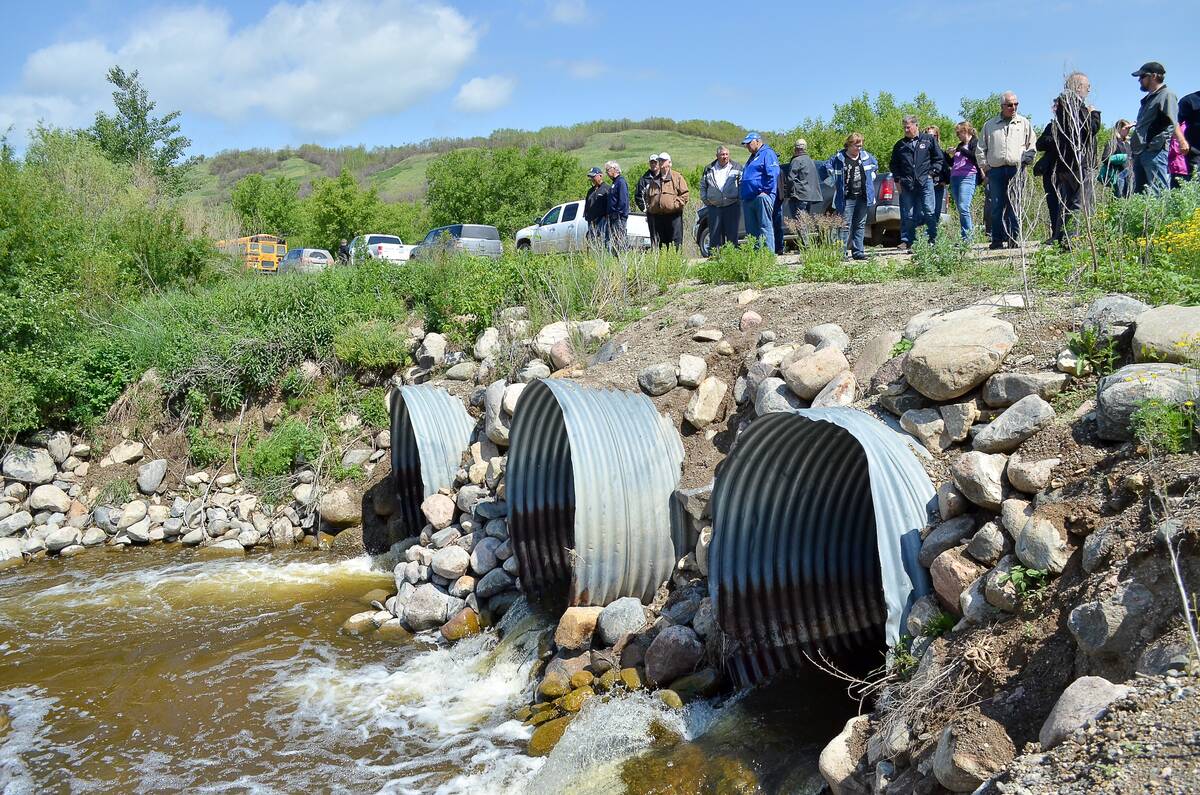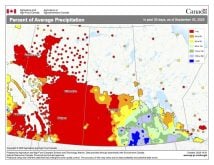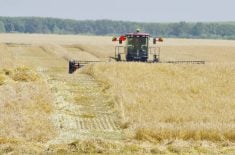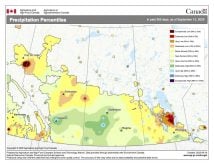Southwest Region
Rainfall last week and over the weekend gave a much needed boost to crops. Much of the Southwest region received 3 to 9 mm while areas immediately south of Riding Mountain Park received more, ranging from 11 to 15 mm. Very dry pockets persist around Hamiota and Melita. Dry topsoil conditions are still a major concern in most of the Southwest region.
- Click here for the Crop Weather Report for the week ending June 9
Read Also

Manitoba Forage and Grasslands Association wins Water Canada innovation award
The farmer-led Manitoba Forage and Grassland Association has earned the Early Adopter/Innovation Partnership Award from Water Canada for the MFGA’s collaborative Aquanty hydrological modelling project for water management.
Seeding ranges from 95 to 100 per cent complete. Some producers are reseeding canola, mainly due to flea beetle damage. Shorter than normal winter cereals are showing signs of nutrient deficiency due to lack of available moisture. Fall rye is heading, and is about 14 inches tall. Winter wheat is at the flag leaf stage, with no signs of foliar disease. Canola was showing some signs of moisture stress early last week, but have somewhat improved after cool humid nights and root development finding deeper soil moisture. Crops are still struggling to advance in most parts of the region. Emergence is very slow due to dry seedbed conditions. Recent rain will benefit to most of the crop. Majority of germinated canola crop is at cotyledon to 1 leaf stage. Flea beetle and cutworms are having a widespread impact in the Southwest region. More than 50 per cent of canola fields sprayed for flea beetles. Sunflowers have emerged with signs of cutworm damage as well as soil crusting issues. Cutworms also noted in cereal crops and sprayed for in some cases. Corn fields are at V3 stage and rated as good. Early seeded spring wheat is at the 3 to 4 leaf stage and tillering. Some later seeded wheat is at 1 to 2 leaf stage. Most crops have had herbicide applications. Soybeans have responded well to recent moisture and warm daytime temperatures, with majority of fields at the unifoliate stage. Field peas rated as good. Height is shorter than normal but good nodulation at this point. Majority of the crop is at 4 to 5 node stage. Herbicide applications complete.
Bertha armyworm traps are up in the area and Diamondback moth numbers are very low in the region.
Forages in need of critical regrowth moisture in addition to recent rainfall. However, fluctuating day and night temperatures from normal to just above freezing continue to negatively impact forage growth. Cattle are now on pasture, but there is still a risk that forage and water sources will not last until the fall. Some farmers are looking at topping up pasture dugouts.
Northwest Region
Variable weather continued in the Northwest region last week. Temperatures reached above 30 C throughout much of the region but overnight lows dipped close to zero. Around Roblin, Swan River and The Pas, frost visible Monday morning, but early reports are that crop damage appears to be minimal. Hail fell near Roblin mid week, although there did not appear to be serious damage. Rainfall amounts varied; The Pas received 30 mm, Dauphin/Ste. Rose 11 to 25 mm; around Swan River area 3 to 10 mm and Roblin area 12 mm. These rainfall events were welcome where soil moisture is lacking however, other areas are still looking for rain as hot weather and wind continues to worsen soil moisture conditions.
Soil moisture conditions around Roblin are 30 per cent adequate, 60 per cent short, 10 per cent very short; Swan River area is rated as 10 per cent very short, 50 per cent short and 40 per cent adequate; soil moisture at The Pas is 90 per cent adequate, 10 per cent surplus.
Overall seeding progress throughout the region is virtually complete for all crops with operations winding down at The Pas. The extent of frost injury from last weekend varies with some fields around Grandview reseeded due to frost damage. There was noticeable growth in the canola this week in areas that received rain; however, the dry soil conditions and hot, windy weather has resulted in patchy emergence and slow growth in many other areas. Silage corn emergence is slow and uneven due to dry seedbed conditions.
Weeds are actively growing and herbicide applications continue as crops develop and weeds become an issue. Diamondback moths are showing up in traps throughout the region with counts well over 200 around Bowsman. There are reports of reseeding and spraying canola in Swan River, and in the Parkland area as flea beetles and cutworm feeding continue. Generally, crops in the Northwest region are rated as good but some canola fields are in very poor condition due to a combination of insect feeding, frost and delayed emergence from dry soils.
Most cattle are being moved to pasture as producers have been waiting for more optimal growth. Frost has slowed hay growth, although alfalfa growth has resumed progressing. Dugout levels still adequate despite dry weather.
Central Region
Highly variable weather occurred during the week. Dry conditions prevailed at the start, becoming very hot on Friday with maximum temperatures reaching 38°C. Combined with strong southerly winds gusting up the 80 km/hr causing localized soil blowing where fields had poor surface cover from crop residue or plant growth. Soil blasting of seedling plants resulted in some of those fields where crops were small. Those fields are being assessed as candidates for reseeding. Saturday conditions cooled to below normal temperatures bringing variable amounts of precipitation to the region. Rain amounts ranged from 4 mm above the escarpment to 27 mm in the Winkler area. The highest amounts of precipitation received were in the north-central part of the region and in the Red River valley. St. Claude area was hit by hail and crop damage assessment is underway.
Wheat, oats and barley crops are well established, and are in the 4 to 6 leaf stage, tillering well. Herbicide spraying is continuing on all crops and growers have been spraying just before the canopy closure to target small weeds that have emerged later. Corn has emerged relatively well and growing as conditions are warming up. Overall seeding is considered done except for the fields that have suffered damage from flea beetle and frost damage or soil blasting from the recent high wind conditions. Ongoing insecticide applications occurring for flea beetles in canola. Diamondback moth traps set up to capture early arrivals of this insect have none above the escarpment but are showing up in the Red River Valley in increasing numbers.
Potato emergence was delayed due to cold soils at planting but no seed rot has been reported so far.
Many fields now emerged. Irrigation of some acres beginning to maintain soil moisture and support growth. Field peas are now in the 5 to 7 node stage. Soybeans have emerged and into the first trifoliate stage. Some emergence issues and poor growth reported in the Red River Valley in canola, corn and soybeans possibly due to dry seedbed. Field bean planting is considered complete; however, some damage reported on fields where soil blasting occurred.
Fall rye fields have headed out and winter wheat remains in the jointing stage. Winter cereals have developed well despite dry conditions.
Field sprayers have been rolling out as more crops are in the right application window for herbicide application. Later planted crops are still establishing and not yet at spray timing.
Haying of dairy-quality alfalfa has started. Quality is very good having dry harvesting conditions but yields are below normal for a first cut due to the lack of moisture. Grasses are starting to head out because of moisture stress. All the forages require significant rainfall to maintain growth rate. Most cattle have been moved onto pastures for grazing. Native hay and pasture have suffered some winter injury and have been slow to recover this spring.
Livestock water supplies are currently adequate but water levels in sloughs and dugouts are dropping due to low water table levels. Feed is in short supply which is making pasture supplementation difficult.
Eastern Region
Rainfall during past weekend was welcomed by all producers. Accumulations across the Eastern region ranged from as little as 5 mm to over 50 mm. Rainfall amounts were highest along the U.S. border and in northwest areas of the Eastern Region. Soil moisture conditions on cropland across the region rated as adequate on 80 per cent of acres with the balance being short to very short. Soil moisture conditions of hay and pasture lands were rated as adequate on 40 per cent of acres with 30 per cent short and 30 per cent very short. Strong winds associated with weekend storms caused a limited amount of seedling sandblasting damage in some fields. A strong wind/suspected tornado event occurred over a limited area north of Beausejour which resulted in some crop and property damage. Daytime temperatures across the region last week were mostly above normal until the weekend. While this promoted crop emergence and growth, producers remain concerned about the cool temperatures forecasted for the coming week.
First pass herbicide applications in corn are near completion in some areas with rapid progress expected this week on remaining acres. Herbicide applications to spring cereals range from about 50 per cent complete to complete across the region. Herbicide applications in soybeans continue with significant progress expected this week if weather allows. A limited amount of canola acres have received herbicide applications so far with further progress expected this week. Producers remain focused on weed control this week making use of every opportunity. Reports of cutworms in cereals, sunflowers and soybeans and flea beetles in canola continue to be received and insecticide applications are ongoing as producers wait for the affected crops to grow out of the problem. Re-seeded crops are being carefully monitored for insect damage.
Winter wheat and fall rye crop condition was rated as good. Winter wheat fields were mostly at the 5 to 6 leaf stage with 2 to 3 tillers. Stems were starting to elongate. Spring wheat and oats remained in good condition with the crop at the 3 to 4 leaf stage with 2 to 3 tillers. Corn staging ranged from V2 to V3 with good overall condition but crop development has been slow. Canola growth staging ranged from cotyledon to 4 leaf stage. Canola crop condition ranged from 20 per cent fair to 80 per cent good due to frost, flea beetles or uneven emergence. Soybean crop stage ranged from emergence to first unifoliate with uneven emergence noted in some fields and stand assessments continuing. In some fields, uneven stands have seen seedlings drying out partway through the germination and emergence process. Sunflower growth stage ranged from cotyledon to early V4 with development noted as slow and crop condition rated as good.
Hayfields were rated as 50 per cent fair, 30 per cent poor and 20 per cent very poor with pasture conditions rated as 40 per cent fair, 30 per cent poor and 30 per cent very poor. Livestock are being moved to pasture and fertilization of hay fields and some pastures occurred last week. Dugout levels have risen from the past weekend’s rain. Availability of livestock water was rated as 100 per cent adequate.
Interlake region
Temperatures have been extremely variable, but have been trending upwards. Daytime temperatures reached the mid 30s C; average temperatures ranged from 15 to 18 C. The 35 C weather on Friday came with damaging winds and thunderstorms. In general, most of the northern part of the Interlake received 5 to 18 mm, average 12 mm. Gimli to Teulon and south saw amounts from 20 to 90 mm. Hail hit an area of about 2500 acres in the Balmoral area, with most damage done to soybeans. Although there is some standing water from higher rainfall amounts, the precipitation was very welcome. Growing degree days, precipitation and corn heat units well below normal for this time of year. Cooler temperatures forecast for the coming week will slow crop advancement.
Seeding is essentially done. Remaining acres are going to greenfeed and underseeded green feed. Re-seeding of canola acres continue. Multiple stresses, including extended cool and dry conditions, along with several frosts and high flea beetle pressure, and sometimes cutworm damage have been hard on the crop. Damaging winds finished off some fields. A few acres will remain unseeded due to extremely dry conditions. Timely rains are needed to support all crops.
Most crops have germinated, but areas of shallow seeded crops, canola in particular, sit in dry soil. Patchy germination is evident in cereal fields, especially on lighter textured soils, and stands are uneven. Topsoil moisture is currently adequate for 60 per cent of the crops and short for 40 per cent.
Rain has evened up some fields, and stands are starting to fill in. Peas range from 5 to 8 node stage. Spring wheat is 3 to 5 leaf and starting to tiller. Oats and barley are similar, and all acres that saw rain have improved in growth and colour. Some re-seeded cereals are germinating and emerging. Most corn – both grain and silage – is planted, ranging up to the V3 stage. Colour is still pale green, and wind damage is evident in many fields. Canola is cotyledon to 4 leaf, with re-seeded acres germinating to emerging. Patchy injury due to frost on earlier seeded canola, with some estimates of 5 to 10 per cent of plants affected. The few flax fields seeded have emerged and are doing well. Soybeans are cotyledon to unifoliate, with first trifoliate emerging. Some fields are beat up due to wind damage. Greenfeed acres are reported to be up significantly, with majority complete. Some oat and barley acres will remain flexible, going as grain or feed as necessary. Millet is going in due to concern about hay and pasture. New hay acres are being seeded, older stands are being renovated. Fall rye is reported to be in boot stage and very short with few tillers. Some forage seed fields – fescues and some timothy – have been written off. Alfalfa is slow to grow, stunted with consecutive frosts.
Weeds are more evident following the recent rain, and producers who were holding off spraying due to lack of weed pressure are now ramping up applications. Spraying will be general this week. Some second applications to canola are starting, and patch treatments for wild oats in both canola and soybeans are being followed up with full field applications. Spraying progress is lower than average, due to conditions and lack of weed growth. Up to 50 per cent of acres are complete in some areas, but well below that in others.
Bertha armyworm traps have been placed in canola fields, and monitoring will begin this week. Diamondback moth numbers are still low to date. An increased number of fields have been treated for flea beetles, and currently entire fields are being sprayed. Populations vary widely over the region, but in some areas as much as 50 per cent of the fields have been sprayed. Some reports of cutworms – with some acres sprayed in corn, canola, soybeans and cereals.
Forage availability is a concern for the region. Pastures were generally overgrazed last fall, compounding concerns, and are two to three weeks behind normal. Regrowth of hay and pasture has been slow with cold, dry conditions. Topsoil moisture is rated as 10 per cent adequate, 80 per cent short and 10 per cent very short. Alfalfa has stretched to 8 to 13 inches, stands are thin. Grasses are 5 to 8 inches tall and also thin. Some pastures are currently being stocked due to exhausted hay supplies. High costs and low feed availability are contributing factors. Pastures are rated as 30 per cent fair to 20 per cent very poor. Hay crops rated as 50 per cent fair to 10 per cent very poor, and first cut yields will be lower than normal. Dugout levels are below normal, and sometimes dry. Water supplies are rated as 90 to 95 per cent adequate. Concern over adequate supply is increasing with continued dry conditions.














